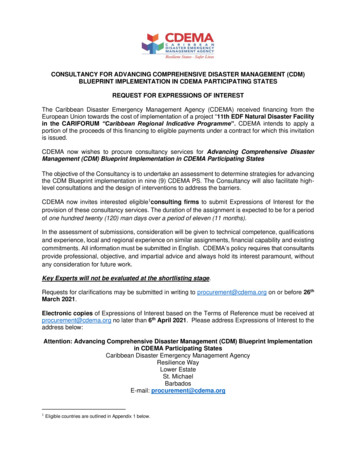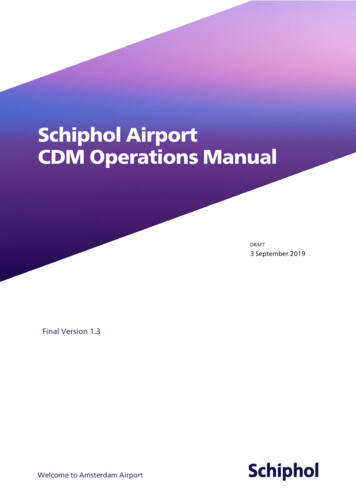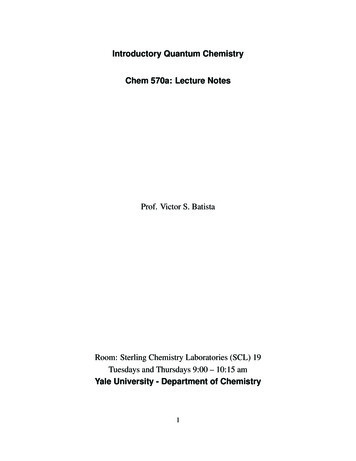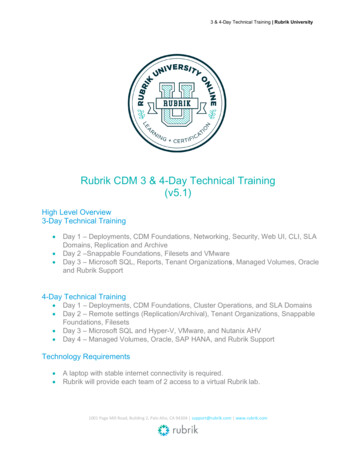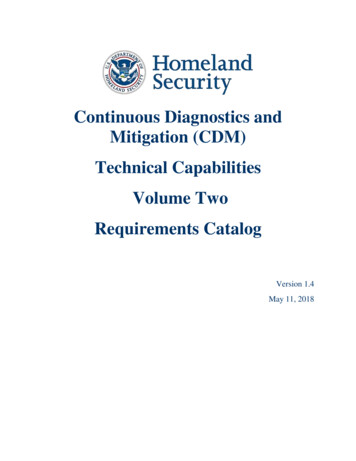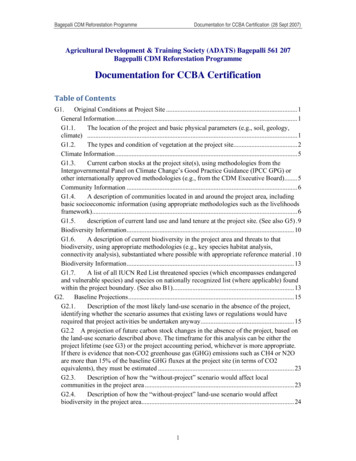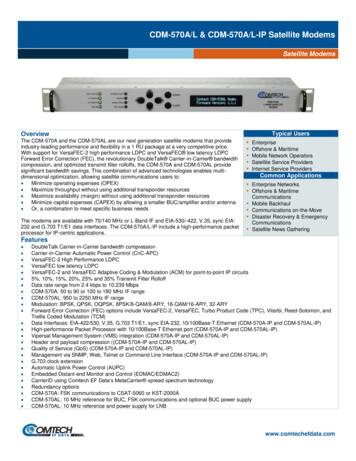
Transcription
CDM-570A/L & CDM-570A/L-IP Satellite ModemsSatellite ModemsTypical UsersOverviewThe CDM-570A and the CDM-570AL are our next generation satellite modems that provideindustry-leading performance and flexibility in a 1 RU package at a very competitive price.With support for VersaFEC-2 high performance LDPC and VersaFEC low latency LDPCForward Error Correction (FEC), the revolutionary DoubleTalk Carrier-in-Carrier bandwidthcompression, and optimized transmit filter rolloffs, the CDM-570A and CDM-570AL providesignificant bandwidth savings. This combination of advanced technologies enables multidimensional optimization, allowing satellite communications users to: Minimize operating expenses (OPEX) Maximize throughput without using additional transponder resources Maximize availability (margin) without using additional transponder resources Minimize capital expenses (CAPEX) by allowing a smaller BUC/amplifier and/or antenna Or, a combination to meet specific business needsThe modems are available with 70/140 MHz or L-Band IF and EIA-530/-422, V.35, sync EIA232 and G.703 T1/E1 data interfaces. The CDM-570A/L-IP include a high-performance packetprocessor for IP-centric applications. EnterpriseOffshore & MaritimeMobile Network OperatorsSatellite Service ProvidersInternet Service ProvidersCommon Applications Enterprise Networks Offshore & MaritimeCommunications Mobile Backhaul Communications on-the-Move Disaster Recovery & EmergencyCommunications Satellite News GatheringFeatures DoubleTalk Carrier-in-Carrier bandwidth compressionCarrier-in-Carrier Automatic Power Control (CnC-APC)VersaFEC-2 High Performance LDPCVersaFEC low latency LDPCVersaFEC-2 and VersaFEC Adaptive Coding & Modulation (ACM) for point-to-point IP circuits5%, 10%, 15%, 20%, 25% and 35% Transmit Filter RolloffData rate range from 2.4 kbps to 10.239 MbpsCDM-570A: 50 to 90 or 100 to 180 MHz IF rangeCDM-570AL: 950 to 2250 MHz IF rangeModulation: BPSK, QPSK, OQPSK, 8PSK/8-QAM/8-ARY, 16-QAM/16-ARY, 32-ARYForward Error Correction (FEC) options include VersaFEC-2, VersaFEC, Turbo Product Code (TPC), Viterbi, Reed-Solomon, andTrellis Coded Modulation (TCM)Data Interfaces: EIA-422/530, V.35, G.703 T1/E1, sync EIA-232, 10/100Base-T Ethernet (CDM-570A-IP and CDM-570AL-IP)High-performance Packet Processor with 10/100Base-T Ethernet port (CDM-570A-IP and CDM-570AL-IP)Vipersat Management System (VMS) integration (CDM-570A-IP and CDM-570AL-IP)Header and payload compression ((CDM-570A-IP and CDM-570AL-IP)Quality of Service (QoS) (CDM-570A-IP and CDM-570AL-IP)Management via SNMP, Web, Telnet or Command Line Interface (CDM-570A-IP and CDM-570AL-IP)G.703 clock extensionAutomatic Uplink Power Control (AUPC)Embedded Distant-end Monitor and Control (EDMAC/EDMAC2)CarrierID using Comtech EF Data’s MetaCarrier spread spectrum technologyRedundancy optionsCDM-570A: FSK communications to CSAT-5060 or KST-2000ACDM-570AL: 10 MHz reference for BUC, FSK communications and optional BUC power supplyCDM-570AL: 10 MHz reference and power supply for LNBwww.comtechefdata.com
Doubletalk Carrier-in-CarrierDoubleTalk Carrier-in-Carrier, based on patented “Adaptive Cancellation” technology, allows transmit and receive carriers of a duplexlink to share the same transponder bandwidth. DoubleTalk Carrier-in-Carrier is complementary to all advances in modem technology,including advanced FEC and modulation techniques. As these technologies approach theoretical limits of power and bandwidthefficiencies, DoubleTalk Carrier-in-Carrier utilizing advanced signal processing techniques provides a new dimension in bandwidthefficiency.Figure 1 shows the typical full-duplex satellite link, where the two carriers are adjacent to each other.Figure 2 shows the typical DoubleTalk Carrier-in-Carrier operation, where the two carriers are overlapping, thus sharing the samespectrum.Figure 1Figure 2When observed on a spectrum analyzer, only the Composite is visible. Carrier 1 and Carrier 2 are shown in Figure 2 for reference only.As DoubleTalk Carrier-in-Carrier allows equivalent spectral efficiency using a lower order modulation and/or code rate, it can reduce thepower required to close the link thereby reducing CAPEX by allowing a smaller BUC/amplifier and/or antenna. Alternatively, DoubleTalkCarrier-in-Carrier can be used to achieve very high spectral efficiencies E.g., DoubleTalk Carrier-in-Carrier when used with 32-ARYmodulation can provide bandwidth efficiency exceeding 8 bps/Hz.When combined with VersaFEC-2 or VersaFEC and optimized transmit filter rolloffs, DoubleTalk Carrier-in-Carrier providesunprecedented savings in transponder bandwidth and power utilization. This allows for its successful deployment in bandwidth-limitedand power-limited scenarios, as well as reduction in earth station BUC/amplifier power requirements.Carrier-in-Carrier is a Registered Trademark of Comtech EF DataDoubleTalk is a Registered Trademark of Raytheon Applied Signal TechnologyVersaFEC is a Registered Trademark of Comtech EF DataCarrier-in-Carrier Automatic Power Control (CnC-APC)The patent-pending Carrier-in-Carrier Automatic Power Control (CnC-APC) mechanism enables modems on both sides of a CnC link toautomatically measure and compensate for rain fade while maintaining the Total Composite Power. In addition to automaticallycompensating for rain fade, CnC-APC also enables the modems to share link margin, i.e. a modem can effectively transfer excess linkmargin to a distant end modem experiencing fade, thereby further enhancing overall availability.VersaFEC-2 High Performance LDPC Forward Error CorrectionCDM-570A now offers a new high performance LDPC FEC specifically designed to optimize performance at low to mid-tier sysmbolrates. VersaFEC-2 long-block provides 38 ModCods (BPSK to 32-ARY) with performance generally better than DVB-S2 at significantlylower latency and short-block provides 36 ModCods (BPSK to 32-ARY) with higher coding gain than first generation VersaFEC andsimilar latency. All higher order constellations are quasi-circular for optimal peak-to-average performance. ACM operation is supportedfor long block and short block for IP/Ethernet traffic in a point-to-point topology.VersaFEC Forward Error CorrectionVersaFEC is a patent-pending system of LDPC codes designed to provide maximum coding gain while minimizing latency. CDM570A/L support Constant Coding & Modulation (CCM) mode of operation with serial and G.703 data interfaces. CDM-570A/L-IP alsosupport Adaptive Coding & Modulation (ACM) for IP/Ethernet traffic when operating in point-to-point topology.The Ultra Low Latency (ULL) codes provide even lower latency compared to standard VersaFEC codes.Optimized Transmit Filter RolloffsCDM-570A/L support 5%, 10%, 15%, 20%, 25% and 35% transmit filter rolloff allowing users to further optimize the link. Carrier-inCarrier combined with VersaFEC and optimized transmit filter rolloffs can provide 50% or more BW savings compared to legacymodems.EDMAC & AUPC OperationThe CDM-570A/L-IP has the ability to monitor and control the distant end of a point-to-point satellite link using EDMAC or EDMAC2.User data is framed and bits are added to transfer control, status, and AUPC information.
ManagementThe modems support SNMP, web-based and command line interfaces for management. The modems can also be configured andmonitored from the front panel, or through the remote M&C port. Ten complete RF configurations may be stored in the modem. Anevent log stores alarm and status information in non-volatile RAM, while the link statistics log stores link performance (Eb/No and AUPCperformance) for monitoring and reporting purposes.G.703 Clock ExtensionMobile networks require precise synchronization of base stations, which is a challenge when using IP backhaul. Most operators areforced to use GPS-based external equipment for site synchronization. CDM-570A/L-IP offers a G.703 clock extension option thatpropagates a high stability reference from hub to the remote. This process does not require additional bandwidth.CarrierIDCDM-570A now incorporate a patent-pending carrier identification (CID) technique that uses Comtech EF Data’s MetaCarrier spreadspectrum technology to embed a unique carrier identification sequence for the transmitted carrier to help identify interfering carriers.CDM-570A with MetaCarrier is used in tandem with the Comtech EF Data’s MCDD-100 MetaCarrier Detection Device to provide acomplete MetaCarrier embedding and decoding solution.High Performance Packet Processor (CDM-570A/L-IP)The high-performance Packet Processor enables efficient IP networking and transport over satellite with header compression, payloadcompression and advance Quality of Service. The advanced QoS combined with header and payload compression ensures the highestquality of service with minimal jitter and latency for real-time traffic, priority treatment of mission critical applications and maximumbandwidth efficiency.The packet processor supports Routed mode as well as Managed Switch Mode of operation. In managed switch mode, it operates as alayer 2 switch with VLAN support, enabling seamless integration with existing infrastructure while providing full optimization includingheader compression and payload compression and advanced QoS.The CDM-570A/L-IP supports a wide range of applications and network topologies.Header Compression OptionThe packet processor incorporates industry-leading header compression for IP/Ethernet traffic. In Routed mode, header compressioncan be enabled on a per route basis and can reduce the typical 40 byte IP/UDP/RTP header to an average of 2 bytes. For TCP/IP, the40 byte header is reduced to an average of 4 bytes. In Managed switch mode, header compression also compresses the Ethernetheader. So a 58 byte Ethernet header with VLAN and IP/UDP/RTP header can be compressed to as little as 2 bytes.For applications such as VoIP, header compression can provide bandwidth savings exceeding 60%. E.g. 8 kbps G.729 voicetransported in an IP/UDP/RTP datagram typically requires 24 kbps in a routed network or approximately 32.4 kbps in a switchednetwork including VLAN header and FCS. With header compression, the same voice call needs approx 9 kbps (before HDLCencapsulation) – a savings of over 60% in a routed network or over 70% in a switched network. Bandwidth requirement for typicalWeb/HTTP traffic is also reduced with TCP/IP header compression.Payload Compression OptionImplemented in the hardware for maximum throughput and efficiency, payload compression can typically reduce the required satellitebandwidth by 20-30%.Quality of Service (QoS) OptionToday’s networks have to support a wide range of applications with diverse requirements. The packet processor incorporates advancedQoS mechanism to ensure the highest service quality with minimal jitter and latency for real-time traffic, priority treatment of missioncritical applications while maximizing bandwidth utilization. Four different QoS modes are available: DiffServ – Industry-standard method of providing QoS enabling seamless co-existence in networks that implement DiffServ. Max/Priority – Provides eight levels of traffic prioritization with the ability to limit maximum traffic per priority class Min/Max – Provides a Committed Information Rate (CIR) to each user defined class of traffic with the ability to allow a higherburstable rate depending on availability VLAN Priority/Max – Available in Managed switch mode when using VLANs. Uses 3-bit 802.1p VLAN priority with ability to seta maximum data rate per priorityPacket processor includes a powerful classifier capable of classifying packets based on Application/Protocol, Source IPAddress/Subnet, Destination IP Address/Subnet, Source Port / Range and Destination Port / Range.
Vipersat Management System Dynamic SCPC carrier allocation & true bandwidth-on-demandUser-defined policies for upstream carrier switchingStar and dynamic mesh capabilities using single hop on-demandGuaranteed bandwidth capabilityVMS Network & Bandwidth ManagementA Vipersat-powered network integrates these advanced modems with a powerful network management tool, the Vipersat ManagementSystem (VMS). In addition to the traditional monitoring and control of the CDM-570A/L-IP modems and the demodulators, the VMSallows these devices to share bandwidth, and when needed, switch automatically to a dedicated SCPC channel. In a Vipersat-powerednetwork, the CDM-570A/L-IP modem takes advantage of its fast acquisition demodulation to allow it to operate in a shared mode.Inbound transmissions (from remote to hub) can be switched from a shared Selective Time Division Multiple Access (STDMA) mode toa dedicated Single Carrier Per Channel (SCPC) connection via a variety of user defined policies or triggers. This enables the network tomore effectively handle real-time connection-oriented applications and reduces both latency and network congestion. Through VMS,dynamic point-to-point mesh connections can also be established between remotes.Upstream SwitchingThrough protocol classification in the remote terminals, the modem initiates automatic switching. VMS establishes dSCPC bandwidthbased on policies that can be individually enabled on a per-remote basis, or globally enabled. Policies can be configured for a variety ofapplications such as VoIP, video (VTC), or based on a load, or via a schedule, Type of Service (ToS), or QoS rules such as IP port orIP address and protocol type. Operators are able to set minimum and maximum data rates for each remote as well as excess datarates for an initial upstream switch.Vipersat Operation ModeVipersat operation is enabled via a FAST feature code. Networks can easily start off in point-to-point or point-to-multipointconfigurations. As the network grows and users wish to take advantage of the bandwidth on-demand savings by implementing aVipersat network, modems can easily be upgraded to Vipersat mode.FAST Feature EnhancementsThe FAST codes make it easy to upgrade the modem capability in the field. New features can be added on site, using FAST accesscodes purchased from Comtech EF Data that can be entered via the front panel.SpecificationsData Rate Range(See user manualfor details)Symbol RateFrequency RangeData Interfaces2.4 kbps to 10.239 (depending on modulation, FEC andframing), 1 bps step with fully independent TX and RX rates4.8 ksps to 3.0 Msps (subject to data rate range, modulationand FEC) [Please see user manual for details on supportedsymbol rates for different modulation and FEC]CDM-570A: 50 to 90 or 100 to 180 MHz, 100 Hz resolutionCDM-570AL: 950 to 2250 MHz, 100 Hz resolutionEIA-422/-530 DCE, V.35 DCE, Sync EIA-232, G.703 T1balanced, G.703 E1 balanced or unbalanced, 10/100Base-TEthernet (option)Modulation & FEC OptionsVersaFEC-2 (Long Block)BPSK 0.488QPSK 0.489, 0.537, 0.586, 0.611, 0.635,0.660, 0.684, 0.7338-ARY 0.521, 0.537, 0.562, 0.586,0.611, 0.635, 0.660, 0.684, 0.708, 0.73316-ARY 0.586, 0.611, 0.635, 0.660,0.684, 0.708, 0.733, 0.757, 0.78232-ARY 0.660, 0.684, 0.708, 0.733,0.757, 0.782, 0.801, 0.831, 0.855, 0.879VersaFEC-2 (Short Block)BPSK Rate 0,489QPSK Rate 0.489, 0.537, 0.586, 0.611,0.635, 0.660, 0.684, 0.7338-ARY Rate 0.521, 0.537, 0.562, 0.586,0.611, 0.635, 0.660, 0.684, 0.708, 0.73316-ARY Rate 0.586, 0.611, 0.635, 0.660,0.684, 0.708, 0.733, 0.757, 0.78232-ARY Rate 0.660, 0.684, 0.708, 0.733,0.757, 0.782, 0.801, 0.831VersaFECBPSK 0.488QPSK 0.533QPSK 0.631QPSK 0.706QPSK 0.8038-QAM 0.576 (ECCM)8-QAM 0.6428-QAM 0.711Data Rate Range18.115 kbps to 1.468 Mbps(Minimum 37 ksps)36.230 kbps to 4.397 Mbps(Minimum 37 ksps)125.081 kbps to 6.596 Mbps(Minimum 80 ksps)234.527 kbps to 9.381 Mbps(Minimum 100 ksps)824.511 kbps to 10.239 Mbps(Minimum 250 ksps)18.115 kbps to 0.489 Mbps(Minimum 37 ksps)36.230 kbps to 1.465 Mbps(Minimum 37 ksps)125.081 kbps to 2 Mbps(Minimum 80 ksps)234.527 kbps to 2 Mbps(Minimum 100 ksps)824.511 kbps to 2 Mbps(Minimum 250 ksps)2.4 kbps to 1.462 Mbps5.2 kbps to 3.200 Mbps6.1 kbps to 3.785 Mbps6.8 kbps to 4.233 Mbps7.8 kbps to 4.818 Mbps8.3 kbps to 5.179 Mbps9.3 kbps to 5.782 Mbps10.3 kbps to 6.401 Mbps8-QAM 0.78011.3 kbps to 7.021 Mbps16-QAM 0.644 (ECCM)12.4 kbps to 7.726 Mbps16-QAM 0.73114.1 kbps to 8.776 Mbps16-QAM 0.78015 .0 kbps 9.361 Mbps16-QAM 0.82916.0 kbps to 9.946 Mbps16-QAM 0.85316.4 kbps to 10.239 MbpsVersaFEC Ultra Low Latency (ULL) CodesBPSK 0.493 (ULL)2.4 kbps to 1.479 MbpsQPSK 0.493 (ULL)4.8 kbps to 2.959 MbpsQPSK 0.654 (ULL)6.3 kbps to 3.923 MbpsQPSK 0.734 (ULL)7.0 kbps to 4.405 MbpsTPCBPSK 5/162.4 kbps to 0.937 MbpsBPSK 21/442.4 kbps to 1.430 MbpsQPSK/OQPSK 21/444.8 kbps to 2.860 MbpsQPSK/OQPSK 3/47.2 kbps to 4.500 MbpsQPSK/OQPSK 7/88.4 kbps to 5.250 MbpsQPSK/OQPSK 0.959.1 kbps to 5.666 Mbps8PSK/8-QAM 3/410.8 kbps to 6.750 Mbps8PSK/8-QAM 7/813.6 kbps to 7.875 Mbps8PSK/8-QAM 0.9515.3 kbps to 8.500 Mbps16-QAM 3/414.4 kbps to 9.000 Mbps16-QAM 7/816.8 kbps to 9.980 MbpsViterbiBPSK 1/22.4 kbps to 1.500 MbpsQPSK/OQPSK 1/24.8 kbps to 3.000 MbpsQPSK/OQPSK 3/47.2 kbps to 4.500 MbpsQPSK/OQPSK 7/88.4 kbps to 5.250 MbpsViterbi Reed SolomonBPSK 1/22.4 kbps to 1.363 MbpsQPSK/OQPSK 1/24.3 kbps to 2.727 MbpsQPSK/OQPSK 3/46.5 kbps to 4.090 MbpsQPSK/OQPSK 7/87.5 kbps to 4.666 Mbps16-QAM 3/413.0 kbps to 4.000 Mbps16-QAM 7/816.8 kbps to 4.666 MbpsTCM Reed Solomon2/3 8PSK TCM8.7 kbps to 4.400 Mbps(Closed network)UncodedUncoded BPSK4.8 kbps to 3.000 MbpsUncoded QPSK/OQPSK9.6 kbps to 5.000 MbpsNote: Data rate specifications reflect CDM-570A/L or CDM-570A/L-IP modemoperating in non-Vipersat mode
Networking Protocols (With optional IP Module)Mode dependent – ITU V.35, or proprietaryexternally synchronizedCDM-570A: matched for 50/75 , 17 dB minimumreturn loss, BNC connectorCDM-570AL: transmit and receive 50 , 17 dB(950 MHz to 2250 MHz) and 19 dB (1000 MHz to1900 MHz) minimum return loss, female Type Nconnector1, 2, 5, or 10 MHz, BNC connectorTX, RX traffic alarms and unit faultsScramblingInput/Output ImpedanceExternal Reference InputForm C RelaysAccuracyPhase NoiseOutput Spectrum/FilteringAlpha (Rolloff)Harmonics and SpuriousTransmit On/Off RatioExternal TX Carrier OffTX Clock OptionsCDM-570ACDM-570AL 1 ppm, 0º to 50ºC 0.06 ppm, 0º to 50ºC(32º to 122ºF)(32º to 122ºF)0 to –25 dBm, 0.1 dB0 to –40 dBm, 0.1 dBstepssteps 0.5 dB over frequency 1.0 dB over frequencyand temperatureand temperature 0.75 degrees RMS 1.2 degrees RMSdouble-sided,double-sided,100 Hz to 1 MHz100 Hz to 1 MHzMeets IESS-308/-309 power spectral mask5%, 10%, 15%, 20%, 25% and 35%-60 dBC/4 kHz from 600 to 2600 MHz (L-Band), from 1to 400 MHz (IF)55 dB minimumBy TTL LOW signal, or RTSInternal (SCT), external (TT), loop timing withsymmetric or asymmetric operation (data interfacedependent)DemodulatorInput Power RangeMax Composite LevelAcquisition RangeAcquisition TimePlesiochronous/Doppler BufferReceive Clock OptionsClock TrackingMonitor FunctionsCDM-570A-30 to -60 dBmCDM-570AL-130 10 log symbol rate,dBm (minimum)-90 10 log symbol rate,dBm (maximum) 35 dBc, up to 40 dBc, up to-5 dBm absolute max.-5 dBm absolute max. 1 to 32 kHz, 1 to 32 kHz,1 kHz step1 kHz step, symbol rate 625 ksps 1 to 200 kHz,1 kHz step, symbol rate 625 kspsHighly dependent on data rate, FEC rate, anddemodulator acquisition range. Example:120 ms average at 64 kbps, Viterbi Rate 1/2 QPSK, 10 kHz acquisition sweep range, 6 dB Eb/No 128, 256, 512, 1024, 2048, 4096, 8192, 16384 or32768 bitsBuffer disabled (RX satellite), buffer enabled(symmetric or asymmetric operation) (data interfacedependent) 100 ppm minimumEb/No, frequency offset, BER, buffer fill status, RXsignal levelDoubleTalk Carrier-in-CarrierDelay RangePower Spectral Density Ratio(Interferer to Desired)Maximum Symbol Rate RatioEb/No DegradationSatellite Restrictions0 to 330 ms-7 dB to 7 dB3:1 (TX:RX or RX:TX)0 dB Power Spectral Density RatioBPSK/QPSK/OQPSK: 0.3 dB8-QAM: 0.4 dB8PSK: 0.5 dB16-QAM: 0.6 dB 10 dB power spectral density ratioAdditional 0.3 dBSatellite in “loop-back” mode (i.e., the transmitstation can receive itself)“Non-processing” satellite (i.e., does notdemodulate or remodulate the signal)RFC 959 – FTPRFC 1112 – IP MulticastRFC 1213 – SNMP MIB IIRFC 1812 – IPv4 RoutersRFC 2045 – MIMERFC 2236 – IGMP v2RFC 2474 – DiffservRFC 2475 – DiffservRFC 2578 – SMIRFC 2597 – AF PHBRFC 2598 – Exp ForwardingRFC 2616 – HTTPRFC 2821 – SMTPRFC 3412 – SNMPRFC 3416 – SNMPv2RFC 3418 – SNMP MIBLow-Noise Block Converter (LNB) Support (CDM-570AL)LNB VoltageLNB ReferenceModulatorFrequency Stability(With Internal Reference)Output PowerRFC 768 – UDPRFC 791 – IPRFC 792 – ICMPRFC 793 – TCPRFC 826 – ARPRFC 856 – TelnetRFC 862 – PingRFC 894 – IPSelectable OFF, 13 VDC or 18 VDC10 MHz via RX center conductor, Selectable ON/OFF0.0 dBm 5 dBBlock Up Converter (BUC) Support (CDM-570AL)BUC Voltage24 VDC, 90 W @ 50 C, 100 W @ 30 C(internally fitted option)48 VDC, 150 W @ 50 C, 180 W @ 30 C(internally fitted option, not available with -24 VDC input)10 MHz via TX center conductor, Selectable ON/OFF0.0 dBm 5 dBVia TX center conductor with FSK BUCsBUC ReferenceFSK SupportEnvironmental & PhysicalTemperaturePower SupplyPower Consumption(See Manual For Details)Dimensions(height x width x depth)WeightOperating: 0 to 50 C (32 to 122 F)Storage: -25 to 85 C (-13 to 185 F)100 to 240 VAC, 50/60 Hz-24 VDC (HW option)-48 VDC (HW option)CDM-570A: 29 W typical (32 W max.) (w/o IP module)CDM-570AL: 29 W typical (32 W max.) (w/o BUC, w/oIP module)CDM-570A: 1.75” x 19” x 13”(4.4 x 48.3 x 33 cm)CDM-570AL: 1.75” x 19” x 16”(4.4 x 48.3 x 40.6 cm)CDM-570A: 6.3 lbs (2.86 kg) (w/o IP Module)CDM-570A-IP: 6.6 lbs (2.99 kg)CDM-570AL: 7.2 lbs (3.27 kg) (w/o BUC P/S, w/o IPModule)CDM-570AL-IP: 8.5 lbs (3.86 kg) (with 24 VDC BUCP/S)Operations & MaintenanceConfiguration andManagementFront panelRemote port – EIA-232 or EIA-485 (2- or 4-wire)10/100BaseT EthernetSNMP with MIB II and private, modem-specific MIBTelnetWeb browser (HTTP)Command Line Interface (CDM-570A/L-IP)Software/firmware upgrade via FTPFaults and alarmsConfiguration backup and restoralSecurityPassword protection for web, ftp and telnetAccess 00CDM-570AL and CDM-570AL-IP: 1:1 Modem Redundancy IF SwitchCDM-570A and CDM-570A-IP: 1:1 Modem Redundancy IF SwitchCDM-570A: 1:10 Modem Redundancy IF Switch ModuleCDM-570AL: 1:10 Modem Redundancy IF Switch ModuleCDM-570A & CDM-570AL: 1:10 Modem Redundancy SwitchAvailable OptionsHow dwareHardwareHardwareHardwareOptionPower supply, AC inputPower supply, -24 VDC inputPower supply, -48 VDC input24 VDC, 90 W @ 50 C (100 W @ 30 C) BUC power supply, ACinput, -24 or -48 VDC input48 VDC, 150 W @ 50 C (180 W @ 30 C) BUC power supply, ACinput or -48 VDC inputDoubleTalk Carrier-in-Carrier boardTurbo Codec board(Required for Rate 0.95. Rate 5/16, 21/44, 3/4 and 7/8 can besupported with or without the TPC board)Packet ProcessorVersaFEC-2 Codec board
FASTFASTFASTFASTFASTFASTFASTFASTFASTFASTFASTModem data rate to 1.1 Mbps for CCM operationModem data rate to 2.5 Mbps for CCM operationModem data rate to 5 Mbps for CCM operationModem data rate to 10.239 Mbps for CCM operation(Maximum data rate limited to 9.98 Mbps in CDM-570Compatibility/Legacy mode. Maximum data rate limited to 9.98Mbps when using TPC codec, 5.25 Mbps when using Viterbi,4.666 Mbps when using Viterbi RS, 4.4 Mbps when usingTCM RS)8PSK, 8-QAM modulation(8PSK requires TPC codec or Reed-Solomon, 8QAM RequiresVersaFEC codec or TPC codec)16-QAM modulation(16-QAM requires VersaFEC codec or TPC codec or ReedSolomon)IP ACM Symbol Rate – 375 ksps, 750 ksps, 1.5 Msps, 2 Msps or3 Msps (Requires Packet Processor and VersaFEC or VersaFEC2)Optimized Transmit Filter Rolloffs (5%, 10%, 15%, 20% and 25%)– 512 kbps, 1.1 Mbps, 2.5 Mbps, 5 Mbps or 10.239 MbpsVersaFEC Codec Data rate (CCM) – 512 kbps, 1.1 Mbps, 2.5Mbps, 5 Mbps or 10.239 MbpsTPC Codec (CCM) for Rate 5/16, 21/44, 3/4 and 7/8(Rate 5/16, 21/44, 3/4 and 7/8 can be supported with or withoutthe TPC board) Not required if TPC board is present.DoubleTalk Carrier-in-Carrier Data Rate (full) – 512 kbps, 1.1FASTFASTFASTFASTFASTFASTMbps, 2.5 Mbps, 5 Mbps, 10.239 Mbps(Requires DoubleTalk Carrier-in-Carrier boardDoubleTalk Carrier-in-Carrier Data Rate (fractional) – 2.5 Mbps, 5Mbps, 10.239 Mbps(Requires DoubleTalk Carrier-in-Carrier boardDoubleTalk Carrier-in-Carrier Automatic Power Control (CnCAPC)(Requires DoubleTalk Carrier-in-Carrier)Reed Solomon CodecG.703 clock extensionCarrierIDPacket Processor Options – Header compression, Payloadcompression, Quality of Service (QoS), VMS IntegrationRegulatoryCE MarkFCCEN 301 489-1 (ERM)EN55022 (Emissions)EN55024 (Immunity)EN 61000‐3‐2EN 61000‐3‐3EN60950 (Safety)FCC Part 15, Subpart BCDM-570ACDM-570AL-IP2114 West 7th Street, Tempe, Arizona 85281 USAVoice: 1.480.333.2200 Fax: 1.480.333.2540 Email: sales@comtechefdata.comSee all of Comtech EF Data’s Patents and Patents Pending at http://patents.comtechefdata.comComtech EF Data reserves the right to change specifications of products described in this document at any time without notice and without obligation to notify any person of such changes. Information inthis document may differ from that published in other Comtech EF Data documents. Refer to the website or contact Customer Service for the latest released product information 2017 Comtech EF Datads-cdm570A-L-IP.docx1/23/2017
performance) for monitoring and reporting purposes. G.703 Clock Extension Mobile networks require precise synchronization of base stations, which is a challenge when using IP backhaul. Most operators are forced to use GPS-based external equipment for site synchronization. CDM-570A/L-IP offers a G.703 clock extension option that
